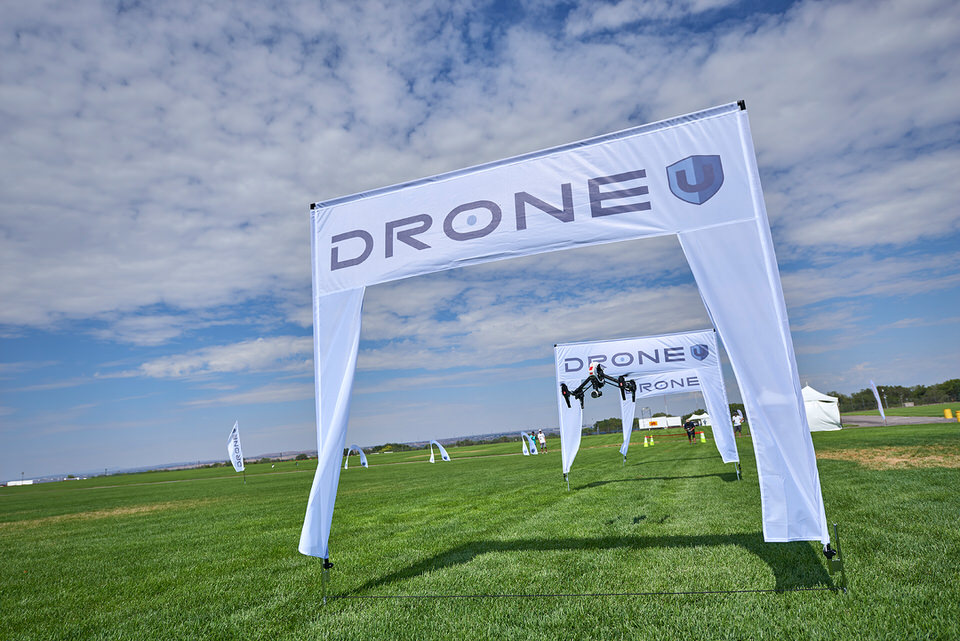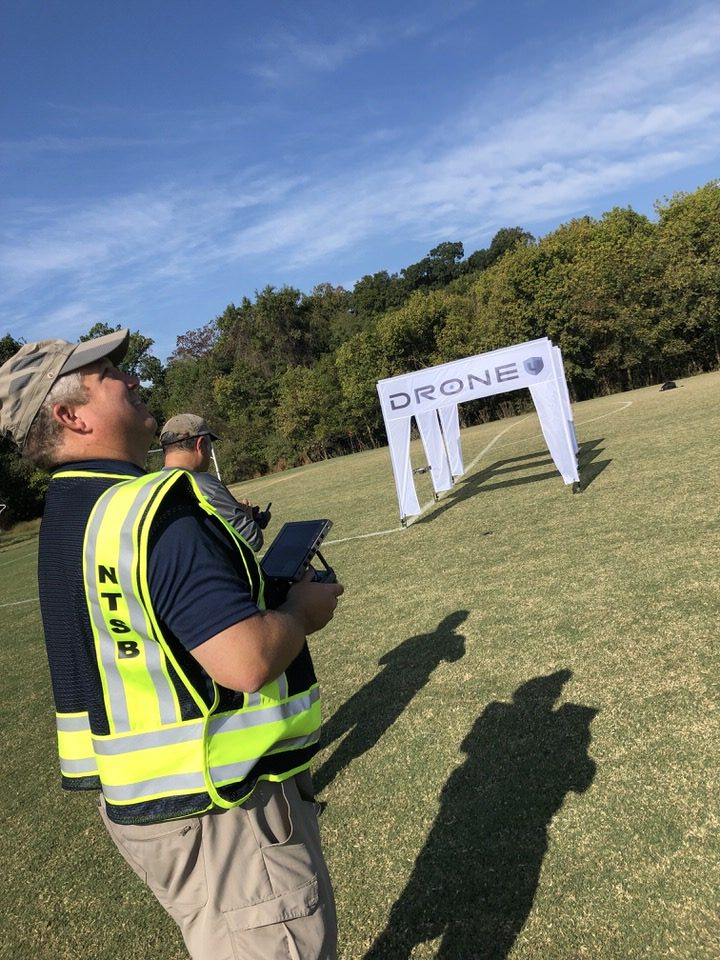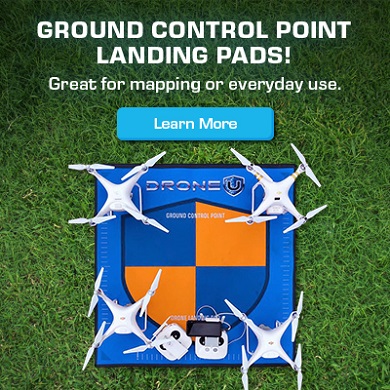









Download our free Part 107 drone certification study guide.

The FAA is actively promoting Drone Safety Week through advertisements, blog posts, podcasts and more. This hype has led to an overdose of information, which is often put together just to get some clicks. We thought it would be a fantastic idea to give you some practical and actionable information. So, let’s go over some tips for flying safely.
Tip #1 – Monitor your Drone Battery Voltage
Are you looking at the correct indicator for your battery? One of the biggest issues that we see with drone pilots all the time is that they’re not factoring in how much flight time they have left. Besides, they’re not factoring in environmental factors when it comes to figuring out how much flight time is truly left.
With that said, there is one true indicator that will allow you to have a very, very firm understanding of exactly how much battery power is left on your drone. And it’s not the battery percentage. The battery percentage does not give you an accurate representation of how much battery power you have left to remain in flight.
The BATTERY VOLTAGE is the true indicator of what’s possible with your drone. We have found that most drones do showcase battery voltage, and typically the consumer drones showcase battery voltage per individual cell in the battery. Since most of these Lithium-Ion, Lithium-Polymer, and Li-HI batteries operate in a certain voltage range, it’s very easy to understand when a safe time to come home truly is. Whether it’s 20 degrees outside or 100 degrees outside, your flight is going to be limited whether it’s too cold or too hot. So how will you know if your battery percentage is accurately telling you how much flight time is left?
And that’s why we teach all of our members in the flight mastery class about battery voltage and having it displayed on the main screen. In DJI, you essentially just click on the battery percentage, scroll to the bottom of that menu and turn on “Show voltage on the main screen” to have it displayed. When the voltage is at 3.60 volts, you know it’s about time to fly home. Whenever it’s 3.60 volts, you should have enough flight time, no matter the temperature to have at least 1500 feet to 2000 feet of “runway to make it home”. As someone who doesn’t trust this smart return to home feature and all the other battery settings, this has been one diagnostic indicator that is proven itself over time with our over 30,000 students.
Tip #2 – Observe the THREE Rules for Safe Drone Takeoff
Something else that we always teach everyone in the Flight Mastery class which is our flagship class and even required by the NTSB for this accident investigators,This practical tip is all about saving yourself and saving the drone upon takeoff. I cannot give you all the rules of takeoff because then I would devalue our material. Our training material is backed by hours of painstaking research and real-world experience, and you’re not going to find any of this stuff on YouTube. And that’s why we’ve never put it out. If you’re expecting to learn how to be a professional pilot from YouTube, you’ve got a lot of lessons coming to you. That being said, let’s go over the first two rules of takeoff and I will negate the third because it’s one of the most important and it’s one of the secrets of Drone U. Here goes –
Rule Number #1 – Always Takeoff into the Wind
Why should do always take off into the wind? Well, number one, it’s going to increase the thrust. And number two, it’s going to help you just get off the ground quickly and decrease the propensity of error during takeoff.
Rule Number #2 – The Drone and the Pilot Should ALWAYS Have the Same Orientation
Now, why is this important?
Well, let me tell you a story. One time I was shooting a little Netflix production down in San Diego with one particular producer who’s still one of my good friends. And he had actually put his drone on top of a Phantom case during takeoff.
And he’s got the drone facing him instead of the drone facing away from him.
I stopped him and I said, “You may want to turn the drone around because when you have the drone facing you, the roll and pitch sticks are inverted”.
He said, “Oh, no, I’m fine”.
He proceeded to takeoff and then hit the leg of one of our Drone U members, Brian. Sorry, Brian!
But it goes to show the importance of the second rule of takeoff. The drone and the pilot should always have the same orientation. Because if you have a gust of wind, if you have someone walking the way bird flies in front of the drone, at least the drone input commands will remain consistent. If the drone has an opposite orientation, your brain is not going to have enough time to realize that and you’ll end up making an error and crashing the drone.
Rule Number #3 – For DU Members Only
The third rule of takeoff. Well, we’re just going to save that for our members How about another practical rule of flight?
Tip #3 – Be Wary of Magnetic Interference
Whenever you’re in the field, getting ready to fly a particular location, what are the first things that you do? Well, we instruct members to look for factors that could obstruct their flight.What potential wireless interference or magnetic interference could have significant problems or cause significant problems to the drone industry? Are there wires around power lines, or a group of people in one particular direction? Well, upon looking at all the different obstacles in the hopper in the operating environment, it’s the second most important thing to do after takeoff.
Now that you have you have reviewed your environment, you need to measure MOCA.
Tip #4 – Determine your MOCA
For the regulators out there who don’t actually fly drones, MOCA means minimum obstacle clearance altitude. This is essentially the minimum altitude that we should set our Return-To-Home. Now if you fly a Skydio 2, you won’t have to worry about this. But if you’re utilizing any other drone in this industry, the first thing you do is measure the MOCA, bring the drone home and set the Return-To- Home altitude. This is fundamentally going to save you in case you have an issue with your drone.
Tip #5 – Prepare an Emergency Response Plan
Now, what’s another practical tip of flying? Well, like manned aviation, you should go through some sort of emergency response training. I’m not talking about responding to an emergency. Rather, as a drone pilot, you need to know how to avoid emergencies altogether.So, for instance, what should you do you’re about to hit something?
Most of you will say, “Hey Paul, I have never even thought about this”.
Huge mistake.
Well, let me remind you of this little saying – “Thumbs up, Buttercup”. That’s right.
Left thumb up whenever you feel like something is going to happen.It’s simple. Well, it’s really hard to hit things if you fly over it. I can’t tell you how many times this has saved my students even in training.
Tip #6 – Invest in Quality Drone Training
If you don’t want to risk your future income, your family finances, and a profession that you love, then I recommend that you check out our Flight Mastery class.While we do have a lot of online classes to serve our community, I truly believe every single person should take at least one in-person class. It’s really difficult to explain the difference and how MUCH this will truly benefit you.
You may know a lot. But, there is a huge difference between “Knowing It” and “Doing it”.
Attending a “Flight Mastery” class will help you build the HABITS and ROUTINES for truly safe drone operations. And, no! Being safe isn’t lame. Being safe gives you all the information that you need to know to fly with more skill. I believe that this is critical. So if you want to be like the thousands of successful drone pilots who have taken our Flight Mastery course, I recommend that you do it.
This course is the only in-person drone operations course where you can earn an educational discount. By passing our check ride at the end of the class, you can gain a very special rate for your drone insurance. Why? Because one particular insurance company Sky watch.ai has realized that the systems taught at a Flight Mastery class do help build habits and routines for safe flight.
So if you want to join the ever-growing list of graduates, I invite you personally to a flight mastery class. And because we’re so keen on flight safety, I’m going to give you a 10% discount on any of our training available through the website. Just go to the Drone U Training Events Page to see all the courses that I personally teach and are coming up.If you go to in-person trainings, you’ll have the opportunity to get training in one of our 10 training locations throughout the United States.
Signing Off…
Hopefully, you enjoyed this information that will help you to not only fly safer but with more skill and confidence in the field. I truly enjoyed the opportunity to share this information with you, and hope that you, like me, realize that being a lifelong learner is critical to the success of yourself and your family over the long term. So if you’re like me, and you’re a lifelong learner, then come fly, have a good time by going to a training that literally will save you the cost of the training over time by utilizing Skywatch. Thanks again.Paul
Become a Drone U Member.
Do not forget to subscribe and listen to Ask Drone U, the #1 drone podcast on iTunes!
Add Your Comment
Some of our most popular topics...
Be sure and check out our page with guides, posts and other helpful information.
Learn MoreTop 10 Blogs
- 1. Autel Evo 2 vs DJI Mavic 3 – Which Drone Should You Buy in 2020?
- 2. Part 107 License FAQ | Your Drone Certificate Questions Answered
- 3. Flying Large Drones Over 55 Pounds Using Section 333 Exemption
- 4. Drone Insurance FAQ's – How to Get the Best and Most Affordable Coverage
- 5. LAANC Apps - Using Kittyhawk and Skyward for Approval
- 6. FAADroneZone - How to Apply for a Part 107 Waiver
- 7. Little Known Facts About Part 107’s “Visual Line of Sight (VLOS)" Rule That You Might Not Be Aware Of
- 8. Should You Get Drone Jobs through Drone Base?
- 9. Flying Drones Over Streets and Moving Traffic
- 10. Best Drones for Flying in the Wind
Top 10 Podcasts
- 1. What should I know about drone insurance?
- 2. BONUS EPISODE: Michael Singer v. City of Newton (City Drone Ordinance Nullified!)
- 3. Is there a place for me in the real estate industry if I lack photography and video skills?
- 4. Is the DJI Spark a good drone?
- 5. INTERVIEW WITH ANDY LUTEN
- 6. How to market your drone business
- 7. DJI Drone Comparison | DJI Phantom 4 Pro, Inspire 1, Inspire 2
- 8. Can I fly my drone over people if I have their consent?
- 9. Drone Photography Pricing for land-only drone jobs
- 10. Can I fly my drone over a road?

Download our No #1 Resource: Part 107 Study Guide
What's Inside this Guide?
- 2500+ pages of FAA material broken into digestible easy to read 279 pages
- Includes over 350 sample quiz & test questions(with answer keys)



